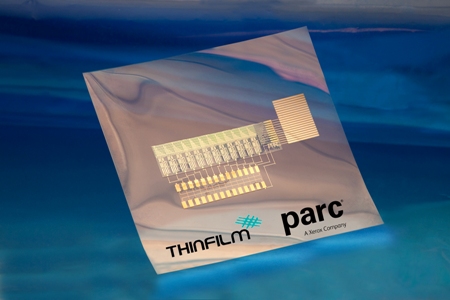PARC, a division of Xerox, and Thin Film Electronics have received the FlexTech Alliance Innovation Award for their first-of-its-kind working model of printed non-volatile memory device that has organic circuits, the organic counterpart of CMOS circuitry.
 Thinfilm Addressable Memory Prototype
Thinfilm Addressable Memory Prototype
The integration of Thinfilm Addressable Memory that comprises PARC’s transistors and Thin Film Electronics’ printed memory with other electronic parts such as antennas, power sources, displays and temperature sensors results in the ‘Internet of things,’ where all are linked by a smart tag. The two firms first revealed the working model in October 2011.
Thin Film Electronics and PARC were assessed on stringent criteria including product design and ingenuity, successful revenue generation and potential market adoption to win the FlexTech Alliance Innovation Award. Innovation Norway’s industrial development grant was used for partially funding the development of the Thinfilm Addressable Memory. Thin Film Electronics’partners Inktec, Solvay and Polyera are also involved in the development program.
According to Davor Sutija, Chief Executive Officer at Thin Film Electronics, its ecosystem comprising display vendors, battery and temperature sensors makes it possible to deliver smart tags and integrated printed devices for the Internet of things.
PARC Electronic Materials and Devices Laboratory’s Vice President, Ross Bringans commented that Addressable memory is a critical component for printed electronics and is equally important in developing novel integrated smart devices.